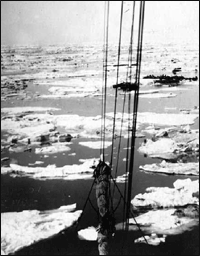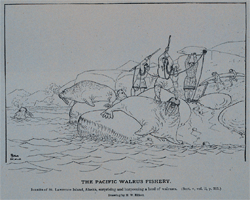|
Unintended Consequences: The Decimation of the Walrus Populations of the Western Arctic
 |
|
Ship Persuing Walrus (Alaska State Library - Historical Collections)
|
In areas where resource exploitation is intense, usually related to a wild capture fishery, it does not take very long to deplete the population of a target species. The fishing vessels are all outfitted for fishing and want to continue to reap the profits, and satisfy the demand, for the product they are targeting, but as the cost to capture, called the “catch per unit effort”, rises to a point where the profit from fishing on that target species approaches the cost of fishing, it becomes difficult to economically justify continuing that fishery. As this threshold approaches, those who are conducting this fishery begin to search for another similar species that is more abundant, can be caught efficiently with minimal alterations to their gear and vessels, and occurs in the same or similar areas in which they are fishing – not wishing to give up their position in the fishing ground for a time when the original target species has recovered. Once found, the cycle continues. Intense exploitation of the new species results in rapid and significant declines in that population, and the fishery moves on again to either another species, or back to the original if it has recovered enough to make it again economically feasible. This cycle is called “serial depletion”, and the Western Arctic in the late 1860”s provides an excellent example of this phenomenon, and especially the potential for the devastating consequences that can arise.
In this period, the bowhead whale populations in the new whaling grounds of the Western Arctic had seen intense whaling. As reported by Bockstoce (1986) “the bowhead population was in steep decline; by 1852, the whalemen had already killed a third of the entire number of bowheads that they would catch from 1849 to 1914, and by 1869 they had already taken two thirds, leaving the remaining third to be captured over the next four and a half decades.” When the fishery began, bowhead whales had never been hunted, and showed no fear of whaleboats, even approaching them out of curiosity, making them very easy to capture. After a few years of intense whaling, this was no longer the case. The effort involved to capture whales increased, and the hunt was on for another species to target. Walrus were plentiful in this area, had only been infrequently taken commercially, so had yet to learn to avoid hunters, would produce an oil that was slightly more valuable than whale oil, and the market demand for oil was high as a result of the Civil War. There was a market for other parts of the animal as well, such as the highly valued ivory tusks. Additionally, bowheads were still present and could be hunted at least part of the season, so if the whaling ships were in the Western Arctic anyway, this offered another source of oil to be taken when the whales were scarce, usually at the beginning and end of the whaling season. And so the harvest began, with the peak between 1868-1883. During this period, the whalers captured approximately 150,000 walrus, with about 85% of these taken between 1869-1878. As Bockstoce (1986) observes, “the total kill was probably twice the size of the catch.” Walrus are difficult to kill – rifles were used for this purpose – and many escaped before they could be captured and the blubber tried out (boiled into oil). If the other walrus take not included in this estimate (from native subsistence take, other traders in the fur trade, for example) is considered, it is clear that the population saw significant and rapid declines. Like the bowhead, it did not take long for walrus to learn to avoid the approaching whaleboats.
 |
|
Walrus on ice in Bering Sea. (Alaska State Library - Historical Collections)
|
Most of the whalers just saw their profit margin decrease with the increasing scarcity of walrus, but a few observed that this was in issue beyond profit. It was the native populations, particularly those in the Western Chukchi Sea, Bering Strait and Northern Bering Sea area that relied on the walrus for sustenance, that were most devastatingly affected. Captain Frederick Barker of the Japan our of Melbourne, Australia, was taken in by Siberian Eskimos and experienced first hand the impact of their intense exploitation of the walrus herds. His letter, published around 1871, in the New Bedford Standard Republican and later in the Whaleman’s Shipping List read, in part: “Should I ever come to the Arctic Ocean to cruise again, I will never catch another walrus, for these poor people living along the coast have nothing else to live upon.” Many in the industry agreed with Barker, but the hunt continued. In 1881, 1000 our of a total population of 1500 natives on St. Lawrence Island died of starvation, attributable at least in part to the decimated walrus populations (but there was disagreement about potential other contributory factors). Other reports of widespread starvation and deprivation of native communities were heard throughout the region.
|